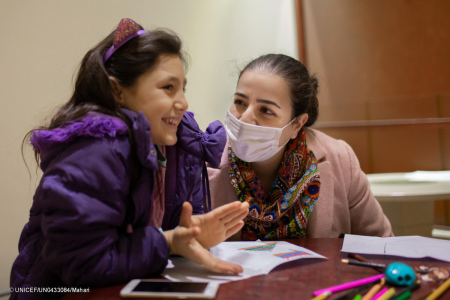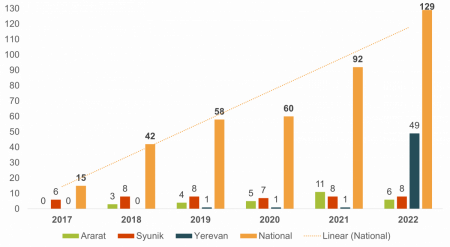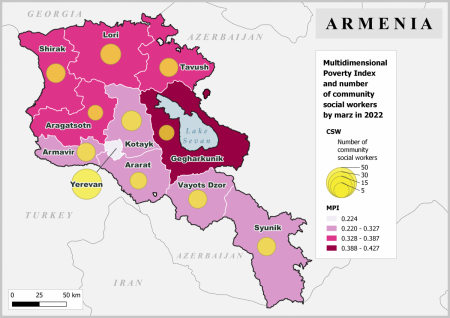
by Alex Collins, Senior Technical Advisor, Data for Impact (D4I) project, Palladium
 A robust social service workforce with the right number and types of social workers and social-service personnel, along with the required competencies and support, is central to the well-being of children, families, persons with disabilities, and other groups who face adversity. To identify promising approaches to strengthen the social service workforce and broader systems related to child care and protection, the USAID-funded Data for Impact (D4I) project has assessed key related activities across three countries—Armenia, Cambodia, and Rwanda.
A robust social service workforce with the right number and types of social workers and social-service personnel, along with the required competencies and support, is central to the well-being of children, families, persons with disabilities, and other groups who face adversity. To identify promising approaches to strengthen the social service workforce and broader systems related to child care and protection, the USAID-funded Data for Impact (D4I) project has assessed key related activities across three countries—Armenia, Cambodia, and Rwanda.
Findings reveal the advantages and challenges in different approaches to plan, develop, and support the workforce. Across the three countries, new positions were established to bring the workforce and services closer to children and families. These roles included community social workers in Armenia, child protection and welfare officers plus Inshuti z’Umuryango (translated as Friends of the Family volunteers) in Rwanda, and provincial to community level social workers and focal points in Cambodia. Improving the numbers and distribution of social service workers or volunteers at lower levels and strengthening their capacity has bolstered the ability of workers to reach those in need.
A Closer Look at Armenia: Legislating the Minimum Number of Community Social Workers
 The Government of Armenia implemented a successful strategy of setting a minimum required number of community social workers. This was coupled with sustained, local financing of these positions. The Law on Local Self-Governance adopted in 2002, and subsequent amendments, established a requirement of 1 community social worker per 5,000 population, which previously was closer to one community social worker per one million total population. From 2017 to 2021, 91 community social workers were recruited and trained in 86 communitie. They were incorporated into staff lists, and funded by communal budgets. As of 2023, the total number of community social workers has risen to 129, reaching the target of one community social worker per 5,000 children nationally.
The Government of Armenia implemented a successful strategy of setting a minimum required number of community social workers. This was coupled with sustained, local financing of these positions. The Law on Local Self-Governance adopted in 2002, and subsequent amendments, established a requirement of 1 community social worker per 5,000 population, which previously was closer to one community social worker per one million total population. From 2017 to 2021, 91 community social workers were recruited and trained in 86 communitie. They were incorporated into staff lists, and funded by communal budgets. As of 2023, the total number of community social workers has risen to 129, reaching the target of one community social worker per 5,000 children nationally.
As described by a key informant, “When the program started, there were only eight community social workers in the regions and one social worker in Yerevan. Now the number has reached [129]. If we ask the question of whether this number of social workers is enough for a country with so many social problems, the answer is no. But comparatively, this number is huge from the perspective of the importance and effectiveness of having social workers in the communities.”
The Future of Social Service Workforce Planning Must Incorporate Demographic Data
 While significant progress was made to increase the number of frontline workers, there is limited use of human resources and demographic data to inform workforce planning. An analysis of the community social workers and their current geographic distribution in Armenia, compared with publicly available multi-dimensional poverty index (MPI) data, shows how current recruitment and deployment practices have yet to incorporate this information.
While significant progress was made to increase the number of frontline workers, there is limited use of human resources and demographic data to inform workforce planning. An analysis of the community social workers and their current geographic distribution in Armenia, compared with publicly available multi-dimensional poverty index (MPI) data, shows how current recruitment and deployment practices have yet to incorporate this information.
As shown in the map to the right, the highest number of community social workers are concentrated in Yerevan, while fewer are posted in areas classified as low- to mid-range on the MPI, and the lowest number is in Gegharkunik, which is at the higher end of the poverty index. A key informant from a local educational institution stated, “We have a serious shortage and uneven distribution of personnel in the regions. We have an accumulated labor force in Yerevan, and we have a problem of finding specialists in the marzes.”
In areas where community social workers are scarce, they can find themselves serving communities of 10,000 or more, negatively impacting the quality of services provided. One expert interviewed for the assessment states that in such districts, “high workload for community social workers…is a problem. Community social workers besides their professional duties, as community workers, carry out other duties as well.” Some Armenian communities have advocated for the integration of a second community social worker position in each community, to address workloads and align with the latest legislation. Similar efforts to increase the number of frontline workers were also reported in Cambodia and Rwanda, but these were based on calculations of workload and workforce-to-population ratios, not the different level of needs in communities.
Governments and implementing partners need to consider how to make a case for investing in the social service workforce by collecting and using demographic data and information on local community needs. The Alliance and its members should consider this question as we envision a future of promise in strengthening the social service workforce.
Stay tuned for an upcoming webinar and the release of global and country-specific reports, which will further present findings from D4I’s assessment of investments in the social service workforce. Click here to recieve email updates to stay informed about their release.
